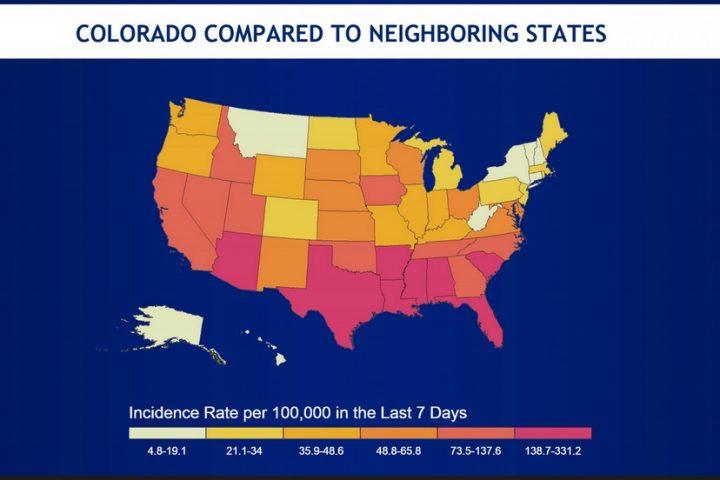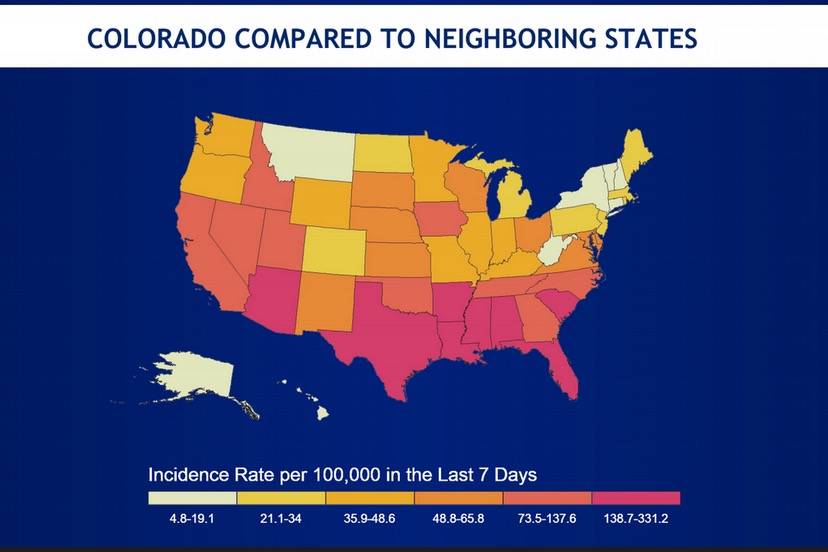We have this unique window of time while virus levels are relatively low, and before we see a potential second wave of COVID-19 infections in the fall, to scale our public health and healthcare systems to be able to support a broader reopening of our communities…
—from Colorado’s ‘Protect Our Neighbors’ health order outline.
On Tuesday, June 30, Colorado Governor Jared Polis extended the ‘Safer at Home and in the Vast, Great Outdoors’ Executive Order, and provided an update on Colorado’s next steps during the COVID-19 pandemic, introducing more details on the ‘Protect Our Neighbors’ framework.
Bars and nightclubs are being ordered to close once again to in-person service — after two weeks of upticks in COVID-19 cases in Colorado and large spikes in two neighboring states. Bars that have taken steps to open as restaurants may continue to operate in-person service, so long as they have patrons seated with their own party only in set seating, spaced six feet apart, and with no mingling. Bars are permitted to sell alcoholic beverages to-go for takeout or delivery consumption if the alcoholic beverages are sold with food.
“‘Protect Our Neighbors’ will allow Colorado to respond more swiftly and effectively at the community level in the event of another surge of cases,” the Governor said. “We live in a diverse state with cities, booming suburbs, small resort towns, and rural areas with plenty of wide-open spaces. Each community is having their own unique experience with this virus. Going forward, we want to increase our ability to tackle outbreaks at a community level and only issue statewide orders when absolutely necessary.”

“We are making some much-needed investments in our local public health agencies, so they can contain and quell an outbreak before it gets out of control. The fate of Colorado in both virus suppression and economic recovery is largely in the hands of Coloradans. If we continue taking the critical steps of staying at home, wearing masks when leaving the house and following social distancing practices, then we will get through this together.”
‘Protect Our Neighbors’ will give local communities more freedom to open their economies while ensuring that they have the necessary public health capacity. The introduction of this new phase means that different parts of the state could be at different phases of reopening, based on local conditions and capabilities.
“Each day, we make progress to build the capacity of our public health system — from ramping up statewide testing sites to onboarding new case investigators and contact tracers systemwide, to identifying creative ways to aggressively acquire PPE,” said Jill Hunsaker Ryan, executive director of the Colorado Dept. of Public Health and Environment. “I am proud of the team at CDPHE who have stood strong during this very difficult time, and I’m grateful for our local public health partners who are leading the response against COVID in their communities. It is important that Coloradans don’t let up now, and this new phase — Protect Our Neighbors — isn’t just words. It means we all accept personal responsibility for the things we can do every day to keep ourselves and others healthy.”
Communities in ‘Protect Our Neighbors’ will be able to permit all activities to occur at 50 percent of pre-pandemic capacity, with at least six feet between non-household members and no more than 500 people in one setting at a time. Local communities may issue more detailed guidelines or public health orders for different settings, so long as the capacity does not exceed these caps.
Moving forward, communities that can demonstrate strong public health and health care systems, paired with low virus levels, can take on more control over their reopening plans. In order to reopen to this greater extent, communities must have:
- Low virus prevalence
- Health care capacity to handle a surge
- Strong public health capacity to contain outbreaks and surges locally, including the ability to test, track, and trace.
In order to qualify for Protect Our Neighbors, a county (or region) must do two things:
- Certify qualification according to the scientific metrics; and
- Submit a mitigation and containment plan on what the county or region will do if they fall out of compliance with any of the metrics.
The containment plan must be accompanied by letters of support from local elected leaders including county commissioners and mayors, the hospitals that serve that community, law enforcement, county emergency management, local public health, and if applicable, tribes.
As we reported last week in the Daily Post, our Pagosa Springs Medical Center does not currently have an Intensive Care Unit (ICU) onsite, and the hospital’s current plan specifies that critical COVID cases will be transferred out of town, to facilities with ICU capabilities. How such a plan would fit into the ‘Protect Our Neighbors’ framework is not immediately clear.
The certification process will begin next week. To learn more about how a community can qualify, click here.

Gov. Polis also announced two new sources of available funding: a Planning Grant and an Infrastructure Strengthening Grant.
All counties or local public health agencies can apply for a Planning Grant of up to $50,000. If counties have already identified infrastructure needs, they may apply for Infrastructure Strengthening Grants, with a maximum state award of $150,000 and a maximum total grant of $300,000. These grants will require local matching funds and can be spent on investments such as technology, community resource coordination, communication activities to increase compliance with the public health orders, funding for community-based partners and cultural brokers, and enhanced prevention and containment efforts.

